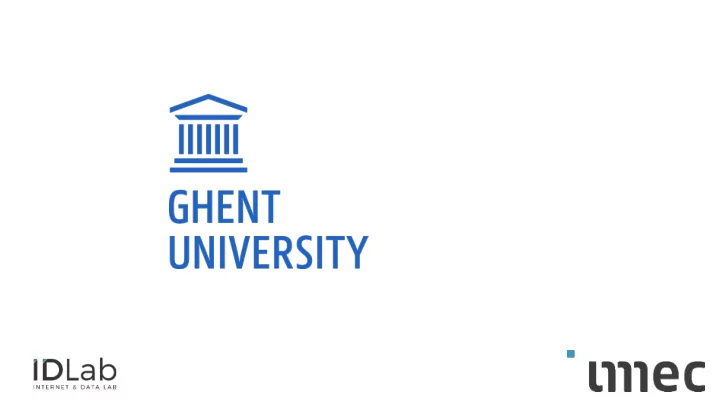

AUTOMATIC (RE)CONFIGURATION OF RSP ENGINES Mathias De Brouwer Stream Reasoning Workshop 2019 in Linköping, Sweden – 17 April 2019
EXAMPLE USE CASE – PATIENT BOB Wearable Motion sensor Sound sensor A0 Query 1: generate Light sensor A1 alarm if value Temperature sensor A2 measured by sensor … A1 is > 250 RSP Localization engine Door/window sensor Diagnosis Bob: Epilepsy patients are sensitive to light epilepsy attack Threshold: light should not go > 250 lumen Medical domain Hospital lay-out Care staff Electronic Health knowledge 3 Record of patients
EXAMPLE USE CASE – PATIENT BOB Wearable Motion sensor Sound sensor A0 Query 1: generate Query 2: generate Light sensor A1 alarm if value alarm if value Temperature sensor A2 measured by sensor measured by sensor … A1 is > 250 A0 is > 30 170 RSP Localization engine Door/window sensor Concussion patients are sensitive to light & sound Diagnosis Bob: Thresholds: light should not go > 170 lumen, concussion sound should not go > 30 decibels Medical domain Hospital lay-out Care staff Electronic Health knowledge 4 Record of patients
GENERAL ISSUE VS. GOAL (Changed) Queries need to be context manually (re)configured Queries of interest are By performing reasoning on automatically derived & changed context instead of on the real-time data streams (re)configured 5
OUR SOLUTION: PROCESS O NTOLOGY SOLUTION I NSTANTIATED MODULE Q UERY S ENSOR Q UERY R ULE ( S ) ( INCLUDES G ENERIC Q UERY ) Output: queries to run on local RSP engine G OAL ( WHAT TO DETECT ) C ONTEXT New or changed Input data (defined once) E.g. for a patient/room 6
EXAMPLE – OVERVIEW OF INPUTS Reasoner goal : look for a Fault {?x a :Fault.} => {?x a :Fault.}. Ontology – relevant definitions (Manchester syntax) & individuals: :LightIntensityAboveThresholdFault ≡ (:hasSymptom some :LightIntensityAboveThresholdSymptom) and ... :LightIntensityAboveThresholdFault ⊆ :Fault :Concussion a :Diagnosis; :hasMedicalSymptom :ConcussionSensitivenessToLight . :ConcussionSensitivenessToLight :hasThreshold :ConcussionLightThreshold . :ConcussionLightThreshold :hasDataValue "170"^^xsd:float ; :isThresholdOnProperty [ a :LightIntensity ] . Context – part about Bob and his room: :Bob a :Person ; :hasRole [ a :PatientRole ] ; :hasLocation :R101 ; :hasDiagnosis :Concussion . :40-a5-ef-05-a4-a6-A0 a :SoundSensor ; :hasLocation :R101 . :40-a5-ef-05-a4-a6-A1 a :LightSensor ; :hasLocation :R101 . :40-a5-ef-05-a4-a6-A2 a :TemperatureSensor ; :hasLocation :R101 . ... 7
WHAT IS THIS SENSOR QUERY RULE ? { ?p :hasRole [ a :PatientRole ] ; :hasLocation ?l ; :hasDiagnosis [ :hasMedicalSymptom [ :hasThreshold [ :hasDataValue ?t ; :isThresholdOnProperty [ a ?prop ] ] ] ] . ?s a :Sensor ; :observes [ a ?prop ] ; :hasLocation ?l . } => { _:x a :Query ; :queryPattern { _:o a sosa:Observation ; :madeBySensor ?s ; Representation :hasResult [ :hasDataValue _:v ] . } ; of generic query :valueThreshold ?t . _:oo a :observation ; :madeBySensor ?s ; :hasResult [ :hasDataValue _:v ] ; :hasSymptom [ a :ThresholdSymptom ; :forProperty [ a ?prop ] ] . } . 8
MAGIC BEHIND SOLUTION MODULE Proof-of-Concept : N 3 Logic & EYE reasoner Reasoner inputs: ▪ Ontology + sensor query rule + context ▪ Rules (OWL-RL & existential rules supported by N3 not in OWL-RL) Reasoner goal: look for a Fault {?x a :Fault.} => {?x a :Fault.}. ➔ EYE reasoner produces a proof with the goal as the last applied rule 9
WHAT IS THIS SENSOR QUERY RULE ? { ?p :hasRole [ a :PatientRole ] ; :hasLocation ?l ; :hasDiagnosis [ :hasMedicalSymptom [ :hasThreshold [ :hasDataValue ?t ; :isThresholdOnProperty [ a ?prop ] ] ] ] . ?s a :Sensor ; :observes [ a ?prop ] ; :hasLocation ?l . } => { _:x a :Query ; :queryPattern { _:o a sosa:Observation ; :madeBySensor ?s ; Representation :hasResult [ :hasDataValue _:v ] . } ; of generic query :valueThreshold ?t . _:oo a :observation ; :madeBySensor ?s ; :hasResult [ :hasDataValue _:v ] ; :hasSymptom [ a :ThresholdSymptom ; :forProperty [ a ?prop ] ] . } . 10
HOW ARE THE QUERIES DERIVED ? <#lemma32> a r:Inference; r:gives { Instantiated _:sk_11 a ns4:Query. _:sk_11 ns4:queryPattern {_:sk_12 a sosa:Observation. _:sk_12 sosa:madeBySensor relevant queries <http://occs.intec.ugent.be/ontology/entity#40-a5-ef-05-a4-a6-A1>. _:sk_12 sosa:hasResult _:sk_13. appear in this proof _:sk_13 a SSNiot:QuantityObservationValue. _:sk_13 DUL:hasDataValue _:sk_14}. _:sk_11 ns4:valueThreshold "170.0"^^xsd:float. _:sk_15 a sosa:Observation. ➔ _:sk_15 sosa:madeBySensor <http://occs.intec.ugent.be/ontology/entity#40-a5-ef-05-a4-a6-A1>. _:sk_15 sosa:hasResult _:sk_16. Can be extracted _:sk_16 a SSNiot:QuantityObservationValue. _:sk_16 DUL:hasDataValue _:sk_17. _:sk_15 SSNiot:hasSymptom _:sk_18. with additional _:sk_18 a SSNiot:ThresholdSymptom. _:sk_18 ssn:forProperty _:sk_19. reasoning step _:sk_19 a SSNiot:LightIntensity. }; r:evidence ( <#lemma46> ... <#lemma57> ); r:rule <#lemma58>. 11
COMPARISON WITH REASONING APPROACH What is the real-time data flow? Classical All sensor data Detected faults after Semantic reasoner approach (e.g. RDFox) (incremental) reasoning Our new All sensor data Detected faults by simple RSP engine approach (e.g. C-SPARQL) pattern matching (no real-time reasoning required anymore) 12
FUTURE STEPS IN THIS RESEARCH Building a first Proof-of-Concept on an extended version of the presented use case Introducing SHACL for the query representation Solving the challenges related to retrieving an RSP engine ready query from the proof Evaluation: comparison with real-time reasoning approach (RDFox?) 13
ir. Mathias De Brouwer PhD Student Ghent University Ghent University – imec @ugent IDLab – Internet Technology and Data Science Lab Ghent University E mrdbrouw.DeBrouwer@UGent.be T +32 9 331 49 38 M +32 484 97 43 15 http://idlab.ugent.be http://idlab.technology
Recommend
More recommend